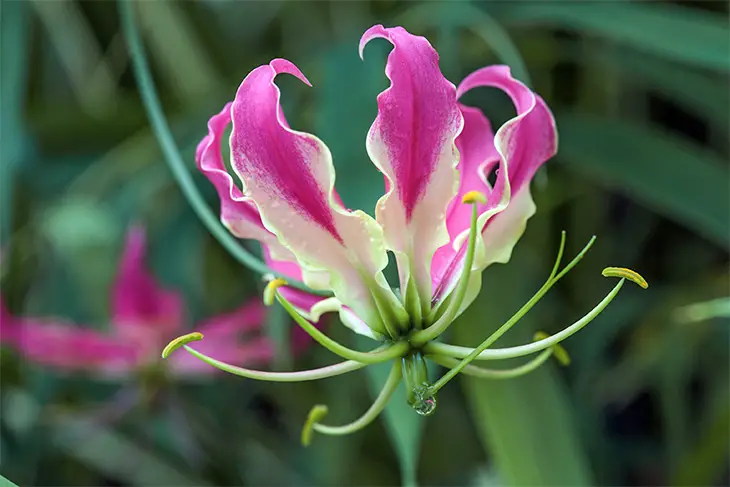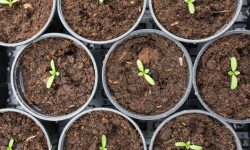Gloriosa lilies are among the most striking flowering plants, admired for their vibrant, flame-like blooms and unique curling petals. Native to tropical regions, these climbers bring an exotic touch to gardens and containers alike. Their bold colors, ranging from fiery reds to golden yellows, create eye-catching displays that can instantly transform any garden space. Growing and maintaining gloriosa lilies requires understanding their specific care needs, including proper sunlight, soil, and watering routines. With attentive care, these lilies can produce spectacular flowers that last through the blooming season, adding elegance and drama to your garden.
Caring for gloriosa lilies goes beyond simple planting. Gardeners must consider seasonal changes, pest prevention, and fertilization strategies to ensure healthy growth and abundant flowering. By mastering these essential tips, you can enjoy a garden full of vibrant, long-lasting blossoms. This guide provides detailed insights on everything from soil preparation to post-bloom care, helping both beginners and experienced gardeners achieve thriving, stunning gloriosa lilies throughout the year.
Understanding Gloriosa Lily

Gloriosa lilies, scientifically known as Gloriosa superba, are tropical climbers admired for their dramatic, flame-colored flowers and uniquely curled petals. Native to Africa and parts of Asia, these lilies are celebrated for their ornamental appeal in gardens, greenhouses, and containers. The vibrant flowers, which can range from red to yellow with striking gradient tones, make gloriosa lilies a favorite for adding height and visual interest to landscapes. Their exotic appearance is often complemented by their ability to produce multiple blooms per stem over the growing season. Despite their striking beauty, these plants require attentive care to thrive, particularly regarding temperature, light, and soil conditions. Understanding the plant’s natural growth patterns is key to promoting strong stems, healthy foliage, and prolonged flowering periods.
Gloriosa lilies grow from tuberous roots that can store energy to fuel successive blooms. The stems are climbing and vine-like, often reaching heights of six feet or more when provided with appropriate support. Each stem can carry several flowers that open sequentially, ensuring continuous color throughout the season. Because of their climbing nature, they need trellises, stakes, or other supports to grow upright. Without support, stems may sprawl, reducing airflow and increasing susceptibility to diseases. Additionally, the plant thrives in warm, humid conditions and is sensitive to frost, making climate consideration crucial when planting outdoors.
These lilies prefer well-draining, rich soil and benefit from partial to full sunlight. While they are hardy in tropical and subtropical zones, gloriosa lilies require protection in cooler climates and may need to be grown in containers that can be moved indoors during winter. Proper watering, fertilization, and monitoring for pests like aphids or spider mites help ensure vigorous growth and extended bloom cycles. By providing optimal care and understanding their unique growth characteristics, gardeners can enjoy the striking beauty of gloriosa lilies year after year.
Selecting the Right Location and Soil
Choosing the right location and soil for gloriosa lilies is essential for ensuring healthy growth and vibrant blooms. These tropical climbers thrive in well-draining, fertile soil enriched with organic matter. Poorly drained soil can lead to tuber rot, especially during the rainy season, which can severely affect flowering. Incorporating compost or well-rotted manure before planting improves soil structure and nutrient content, supporting vigorous root development. Slightly acidic to neutral soil, with a pH between 6.0 and 7.0, is ideal. A well-prepared planting bed not only helps establish the tubers but also enhances bloom production and overall plant resilience.
Sunlight exposure is equally important for gloriosa lilies. They prefer locations that receive at least six hours of direct sunlight daily, although some afternoon shade can help protect the foliage in extremely hot climates. Partial shade works well in tropical regions where intense sunlight can scorch leaves. Proper spacing is also crucial, allowing enough room for the climbing stems to spread without overcrowding. Overcrowding can reduce airflow and increase susceptibility to fungal infections, negatively affecting both foliage and flowers.
When planting in containers, choose deep pots to accommodate tuber growth and provide stability for climbing stems. Containers allow mobility, so lilies can be moved indoors during cooler months or extreme weather. A trellis or other vertical support should be installed at planting time to guide the climbing stems. Water the soil thoroughly after planting, keeping it consistently moist but not waterlogged. Proper soil preparation and careful location selection lay the foundation for a thriving gloriosa lily that rewards gardeners with dramatic, long-lasting blooms.
Watering and Feeding Gloriosa Lily for Optimal Growth
Proper watering and feeding are essential for gloriosa lilies to produce vibrant, long-lasting blooms. These tropical climbers prefer consistently moist soil, especially during active growth and flowering periods. Overwatering, however, can cause tuber rot, so it is crucial to maintain well-draining soil and water deeply but infrequently. Check the soil regularly, ensuring the top inch remains slightly dry before the next watering. In dry climates, mulching around the base helps retain moisture and regulate soil temperature, preventing stress that could affect flower production.
Feeding gloriosa lilies with the right nutrients supports robust growth and prolific flowering. During the growing season, apply a balanced, slow-release fertilizer every four to six weeks to provide essential nutrients without overwhelming the plant. Liquid fertilizers can also be used every two weeks for a faster nutrient boost. Avoid excessive nitrogen, which promotes leafy growth at the expense of flowers. Instead, focus on fertilizers higher in phosphorus and potassium, which encourage strong root development and vibrant blooms.
Adjust feeding and watering routines according to the plant’s growth stage. During dormancy, reduce water to prevent tuber decay and halt fertilization until new shoots emerge. Monitor your lilies for signs of nutrient deficiency, such as yellowing leaves or weak stems, and respond promptly with appropriate fertilization. Proper watering and feeding practices create optimal conditions for gloriosa lilies to thrive, ensuring healthy foliage and abundant, colorful flowers that can delight your garden throughout the season.
Sunlight and Temperature Requirements for Gloriosa Lily
Gloriosa lilies thrive in warm, sunny environments that mimic their native tropical habitats. For optimal growth and flowering, these climbers require at least six to eight hours of direct sunlight daily. Morning sunlight is particularly beneficial, as it encourages strong stem development and vibrant blooms, while afternoon light can be filtered to prevent leaf scorching in extremely hot climates. Insufficient sunlight often results in weak growth, fewer flowers, and elongated stems that struggle to support the weight of the blooms.
Temperature plays a crucial role in the health and blooming cycle of gloriosa lilies. They prefer daytime temperatures between 70 and 85 degrees Fahrenheit and nighttime temperatures no lower than 60 degrees Fahrenheit. Sudden drops in temperature can stress the plant, slow growth, and delay flowering. In regions with cooler climates, consider growing gloriosa lilies in containers that can be moved indoors during cold spells or providing protective covers to maintain warmth during unexpected frosts.
Maintaining stable warmth and bright light encourages strong vine growth and abundant flowering. In indoor or greenhouse settings, ensure good air circulation to prevent fungal issues while keeping the temperature consistent. By carefully balancing sunlight and temperature conditions, gardeners can enjoy prolonged bloom periods, healthier foliage, and the spectacular, fiery flowers that gloriosa lilies are renowned for.
Supporting and Training the Vines
Proper support is essential for Gloriosa lilies, as their long, climbing stems need guidance to grow upright and display blooms effectively. Without support, the vines can sprawl on the ground, which may cause stems to break or flowers to be obscured. Using trellises, stakes, or even netting helps maintain plant structure and showcases the striking, fiery flowers. Position supports early in the growing season to avoid disturbing the delicate roots and stems later.
Training the vines involves gently wrapping or tying them to the support structure. Soft plant ties or strips of fabric work well, as they prevent damage to the stems. Regularly check the ties to ensure they are not too tight as the vine grows. Guiding the stems along the support encourages upward growth, improves air circulation around the plant, and reduces the risk of fungal infections. Properly supported and trained vines also optimize sunlight exposure, allowing leaves and blooms to photosynthesize efficiently and reach their full potential.
Additionally, rotating the plant periodically can help balance growth, ensuring all sides receive adequate light. For container-grown Gloriosa lilies, use a combination of stakes and rings to form a climbing framework. Indoors, training can be done along window frames or trellises placed near bright light sources. This careful attention to support and training results in stronger stems, prolonged flowering, and a visually stunning display throughout the blooming season.
Seasonal Care for Gloriosa Lily
Spring Growth and Early Development
As temperatures rise in spring, Gloriosa lilies break dormancy and begin producing new shoots. This is the critical period for establishing strong growth. Ensure the soil is well-prepared, loose, and enriched with compost to provide essential nutrients. Remove any mulch applied during winter to prevent fungal issues and allow shoots to emerge unimpeded.
Monitor the emerging vines for signs of pests or disease, as young shoots are particularly vulnerable. Provide a trellis or support system early to guide growth and prevent tangling. Early attention to soil, sunlight, and support ensures a robust framework for the plant’s long blooming season. Regularly check moisture levels to avoid both under- and overwatering, as young plants are sensitive.
Fertilizing lightly at this stage with a balanced fertilizer promotes vigorous foliage and prepares the plant for flowering. Applying a layer of organic mulch around, but not on top of the base, helps retain soil moisture and temperature. With proper care during spring, Gloriosa lilies establish strong roots and healthy vines, setting the foundation for abundant summer blooms.
Summer Maintenance and Flowering
During the peak summer months, Gloriosa lilies require consistent care to maintain vibrant flowers. Continue watering deeply but avoid waterlogging, as the roots remain active and flowers demand energy. Deadhead spent blooms regularly to encourage continuous flowering and redirect energy to developing corms.
Check for pests such as aphids, spider mites, or thrips, which are more active in warmer conditions. Apply insecticidal soap or neem oil if necessary, focusing on the undersides of leaves where insects often congregate. Inspect plants weekly to catch early signs of infestation.
Adequate summer maintenance maximizes flower production. Provide partial shade during the hottest parts of the day in extremely warm regions to prevent heat stress. Supporting the vines with stakes or trellises prevents breakage from wind or heavy blooms. Regular monitoring, pest control, and proper watering ensure long-lasting and vibrant flowers throughout the summer.
Fall Transition and Preparing for Dormancy
As temperatures begin to cool, Gloriosa lilies enter a transitional phase. Gradually reduce watering to allow foliage to naturally yellow and die back, signaling the end of the active growth season. This helps corms store energy for next year’s growth.
In colder regions, lift corms for indoor storage to protect against frost. Clean and dry the corms thoroughly, then store them in a cool, dry, and ventilated area. In warmer climates, leave the corms in the ground, applying a light mulch layer to protect them from cooler nights.
Fall care also involves inspecting the plant for any remaining pests or disease, removing affected leaves or stems, and preparing soil for the next season. Adequate preparation during this time ensures that Gloriosa lilies start strong in spring, producing vigorous shoots and healthy blooms year after year.
Common Pests and Diseases and How to Manage Them
Sap-Sucking and Flower-Damaging Insects
Gloriosa lilies are often targeted by small, sap-feeding and flower-damaging insects. These pests extract nutrients from stems and leaves, causing curled, yellowing foliage, stunted growth, and discolored or streaked flowers. Infestations can develop quickly, particularly in warm, humid conditions, and may also attract other harmful insects or facilitate the spread of plant viruses.
To control these invaders, regularly inspect the plants, paying close attention to tender new shoots and the undersides of leaves. A strong jet of water can remove light infestations, while applications of insecticidal soap or neem oil help manage more persistent problems. Reapplication every seven to ten days may be necessary for ongoing protection. Encouraging beneficial insects, such as ladybugs or lacewings, provides a natural method to reduce populations. Additionally, maintaining proper spacing and air circulation around Gloriosa lilies creates an environment less favorable for these damaging insects and supports overall plant health.
Fungal Diseases
Gloriosa lilies are susceptible to several fungal diseases, including powdery mildew and leaf spot. Powdery mildew appears as a white, powdery coating on leaves and stems, while leaf spot causes brown or black lesions that can weaken the plant and reduce flowering. These diseases thrive in humid conditions and poorly ventilated areas.
Prevent fungal infections by ensuring proper spacing between plants to allow air circulation. Water the soil directly rather than overhead, keeping foliage dry, and remove any infected leaves promptly. Fungicidal sprays may be used if the problem persists, following label instructions carefully. Maintaining healthy soil and avoiding excessive nitrogen fertilization also reduces susceptibility, allowing your Gloriosa lilies to remain vibrant and productive throughout the season.
Pruning and Deadheading Techniques
Pruning and deadheading are essential practices for maintaining healthy Gloriosa lilies and encouraging prolonged blooming. Removing spent flowers prevents the plant from directing energy into seed production, allowing it to focus on developing new buds. Deadheading should be done carefully using clean, sharp scissors or pruning shears to avoid damaging the stems or surrounding foliage. Regularly cutting back faded blooms helps maintain a tidy appearance and promotes more vigorous growth.
In addition to deadheading, occasional pruning of overgrown or weak stems improves air circulation and sunlight penetration, reducing the risk of disease. Trim back any yellowing or damaged leaves to keep the plant looking fresh and healthy. For mature vines, selectively pruning longer stems can help direct the plant’s energy into producing more flowers on the remaining branches. Consistent pruning and deadheading not only enhance flowering but also encourage stronger, sturdier growth, making your Gloriosa lilies more resilient to pests, diseases, and environmental stress.
Regular monitoring is key when pruning and deadheading Gloriosa lilies. Inspect your plants weekly to identify spent flowers, weak stems, or damaged foliage. Prompt removal of these parts prevents the spread of disease and reduces competition for nutrients among the healthy shoots. By staying attentive, gardeners can ensure continuous blooms, maintain the plant’s aesthetic appeal, and support robust, long-lasting growth throughout the flowering season.
Propagation Methods: Seeds, Tubers, and Cuttings
Propagation by Seeds
Gloriosa lilies can be propagated from seeds, though it is a slower method compared to tubers. Start by soaking the seeds in warm water for 24 hours to soften the hard coat and improve germination rates. Plant the seeds in a well-draining seed-starting mix, keeping them just below the soil surface. Maintain a consistently warm temperature between 70–75°F and ensure bright, indirect light for optimal growth. Germination typically takes three to four weeks, and patience is required, as seedlings grow slowly initially.
Once seedlings develop two to three sets of true leaves, they can be transplanted into individual pots. Gradually acclimate them to outdoor conditions before planting in the garden. Using seeds allows gardeners to explore genetic variation, resulting in unique flower colors and forms. Though seed propagation takes longer to produce flowering plants, it is an effective way to expand your Gloriosa collection while preserving genetic diversity. Consistent care, including regular watering and protection from pests, ensures healthy seedlings that will develop into robust flowering vines.
Propagation by Tubers
Tubers are the most common and reliable method for propagating Gloriosa lilies. Start by selecting healthy, mature tubers during their dormancy period. Inspect them for signs of rot or damage and discard any unhealthy ones. Plant tubers horizontally in well-draining soil, covering them lightly with 2–3 inches of soil. Keep the soil moderately moist and maintain warm temperatures to encourage sprouting.
Tubers produce faster results than seeds, often flowering within one growing season. They can also be divided carefully to produce multiple plants. Ensure each division has at least one growth bud to guarantee successful sprouting. Tubers require minimal care once established, but protection from excessive moisture is essential to prevent rot. Propagating through tubers allows gardeners to reliably preserve desired flower traits, maintain consistency in color and bloom size, and expand their garden with minimal risk. Proper planting and maintenance of tubers ensure strong, healthy plants that thrive year after year.
Propagation by Cuttings
Stem cuttings offer another method to propagate Gloriosa lilies, particularly when tubers or seeds are unavailable. Take cuttings from healthy, non-flowering shoots during the active growing season. Each cutting should be 4–6 inches long and include at least two nodes. Remove lower leaves to reduce moisture loss, and dip the cut end in a rooting hormone to improve success rates.
Plant the cutting in a well-draining, sterile medium and maintain consistent warmth and humidity. Covering with a clear plastic dome or bag helps retain moisture and encourages root development. Roots typically form in four to six weeks, after which cuttings can be transplanted into individual pots or directly into the garden. Using cuttings preserves the exact characteristics of the parent plant, including flower color and growth habit. This method is ideal for gardeners seeking rapid propagation while maintaining uniformity in their Gloriosa lilies.
Troubleshooting Common Growth and Blooming Issues
Slow Growth and Weak Vines
Gloriosa lilies may sometimes exhibit slow growth or produce weak, spindly vines, often due to insufficient sunlight, poor soil quality, or improper watering. These conditions limit the plant’s ability to photosynthesize effectively and develop strong stems capable of supporting abundant blooms. Overcrowding and competition from nearby plants can also restrict growth, reducing overall vigor.
To correct slow growth, ensure the lilies are planted in a location receiving full sun for at least six hours daily. Improve soil quality by incorporating organic matter, such as compost or well-rotted manure, to enhance nutrient content and drainage. Water consistently, keeping the soil moist but not waterlogged. Regularly monitor plant spacing and prune surrounding vegetation to reduce competition. Supporting young vines with trellises or stakes can also help promote upright growth and stronger stems, ultimately leading to more robust flowering in the season.
Poor Flower Production
A Gloriosa lily may produce few or no flowers despite appearing healthy, usually due to nutrient imbalances, improper pruning, or environmental stress. Excessive nitrogen fertilization encourages leafy growth at the expense of blooms, while inadequate sunlight or extreme temperatures can prevent flower initiation. Overcrowded or poorly ventilated planting areas may also inhibit flowering.
To improve flower production, apply a balanced fertilizer with a higher phosphorus content to stimulate bud development. Ensure the plant receives sufficient sunlight and protect it from extreme heat or cold. Prune older or damaged stems to redirect energy into flowering shoots. Maintain proper spacing and airflow to reduce stress and disease risk. Regular observation and timely care adjustments allow Gloriosa lilies to achieve their full flowering potential, providing vibrant and long-lasting blooms throughout the season.
Yellowing Leaves and Leaf Drop
Yellow leaves and premature leaf drop are common issues in Gloriosa lilies, often signaling nutrient deficiencies, overwatering, or root stress. This condition can weaken the plant, reducing its ability to support blooms and making it more susceptible to pests and diseases. Environmental stressors such as prolonged drought, sudden temperature fluctuations, or poor soil drainage exacerbate leaf yellowing.
To resolve this problem, check soil moisture levels and adjust watering practices to prevent waterlogged or excessively dry conditions. Fertilize appropriately with a balanced, slow-release fertilizer to replenish essential nutrients. Remove yellowed leaves carefully to prevent fungal infections and improve air circulation. Mulching around the base helps retain moisture, moderate soil temperature, and protect roots. By addressing these factors promptly, Gloriosa lilies can regain vigor, maintain healthy foliage, and support abundant flower production throughout the growing season.
Tips for Extending Flowering Period
Regular Deadheading for Continuous Blooms
To extend the flowering period of Gloriosa lilies, regularly remove spent flowers. Deadheading prevents the plant from channeling energy into seed production, allowing more resources to support new blooms. Use clean, sharp scissors or pruners to cut flower stalks just above the nearest set of healthy leaves. This simple practice encourages the growth of fresh buds and promotes a longer, more vibrant flowering season.
Consistency is key—check your lilies every few days during peak bloom. Removing faded flowers promptly ensures the plant remains focused on producing additional blossoms rather than diverting energy to aging blooms. In addition, deadheading helps maintain a tidy, aesthetically pleasing appearance in the garden. Combined with proper watering, fertilization, and sunlight, this method significantly enhances the overall flowering period, ensuring your Gloriosa lilies provide color and beauty well into the growing season.
Balanced Fertilization and Soil Care
Providing the right nutrients is essential for prolonging the flowering of Gloriosa lilies. Use a balanced fertilizer with higher phosphorus content to encourage flower production rather than excessive leafy growth. Apply fertilizer according to the manufacturer’s instructions, usually every four to six weeks during the growing season, to sustain energy for continuous blooms. Avoid over-fertilizing, especially with nitrogen-rich products, as this promotes lush foliage at the expense of flowers.
Enhancing soil quality also plays a significant role. Incorporate organic matter such as compost or well-rotted manure to improve soil structure, moisture retention, and nutrient availability. Healthy soil supports strong root systems, which in turn enables sustained flowering. Regularly monitor soil moisture, ensuring it remains consistently damp but well-drained. By combining careful fertilization with attentive soil management, Gloriosa lilies can maintain prolonged, vibrant blooms that enrich any garden space.
Optimal Light and Temperature Conditions
Light and temperature significantly influence the duration of Gloriosa lily blooms. These lilies thrive in bright, indirect sunlight, which encourages robust flower development and prevents premature bud drop. Ensure they receive at least six hours of light daily, adjusting the location or providing shade if temperatures rise excessively.
Temperature fluctuations can also impact flowering. Extreme heat may shorten bloom longevity, while sudden cold spells can halt bud formation. To maintain an extended flowering period, protect plants from harsh afternoon sun using shade cloth or natural garden structures. In cooler climates, consider starting tubers indoors or using protective coverings during cold snaps. By carefully regulating light exposure and temperature, gardeners can effectively prolong the flowering season of Gloriosa lilies, ensuring vibrant displays throughout summer and early fall.
Harvesting Gloriosa Lilies for Display
Harvesting Gloriosa lilies for indoor arrangements requires careful timing to ensure both beauty and longevity. The best moment to cut the flowers is when the buds are just beginning to open, with the petals starting to curl back but not yet fully expanded. At this stage, the flowers will continue to open indoors, providing a longer display period. Always use sterilized scissors or garden shears to cut the stems at an angle, which allows for better water absorption once placed in a vase. Harvesting in the early morning or late evening, when the plant is well-hydrated, also helps preserve freshness.
After cutting, immediately place the stems in a bucket of lukewarm water to prevent wilting. Remove any leaves that would sit below the waterline in a vase, as they can quickly decompose and promote bacterial growth. For best results, use a clean vase filled with fresh water and change it every two days. Adding a floral preservative or even a homemade solution of sugar and lemon juice can extend the life of the blooms. Proper care after harvesting is crucial to maintaining the lilies’ vibrant colors and distinctive form indoors.
Arranging Gloriosa lilies in displays allows their dramatic, flame-like petals to shine, whether as a focal point or as an accent in mixed bouquets. Their climbing, curling stems add an elegant sense of movement to arrangements, making them popular choices for weddings, special events, or everyday home décor. Pairing them with complementary flowers such as roses, orchids, or lilies of different hues enhances their striking effect. By following proper harvesting and post-care practices, gardeners can enjoy the exotic beauty of Gloriosa lilies not only outdoors but also as stunning indoor decorations.
FAQ About How to Care for Gloriosa Lily
How often should I water Gloriosa lilies?
Gloriosa lilies prefer consistently moist soil during active growth but dislike waterlogging. Water deeply once or twice a week, depending on rainfall and climate. Reduce watering as the plant enters dormancy to prevent tuber rot. Always allow the top layer of soil to slightly dry before the next watering.
Can Gloriosa lilies grow indoors?
Yes, Gloriosa lilies can be grown indoors in containers, provided they receive plenty of bright, indirect sunlight and a climbing structure for support. Maintain warm temperatures and high humidity for best growth. Indoor cultivation requires careful watering and good air circulation to prevent fungal diseases from developing.
When should I dig up Gloriosa lily tubers?
Tubers should be dug up once the foliage has completely died back at the end of the growing season. This ensures the plant has stored enough energy for next year. Gently lift them, clean off soil, and store in a cool, dry, frost-free place until the next planting season arrives.
Are Gloriosa lilies toxic to pets?
Yes, Gloriosa lilies are highly toxic to cats, dogs, and even humans if ingested. The tubers contain colchicine alkaloids that can cause severe gastrointestinal and organ damage. Always plant them in areas away from pets and children, and handle tubers carefully with gloves when dividing or storing them.
How can I extend the blooming period of Gloriosa lilies?
To prolong flowering, regularly deadhead spent blooms, provide balanced fertilizer every few weeks, and maintain consistent watering. Protect plants from extreme heat or cold, which may shorten the bloom cycle. With proper care and staggered planting, Gloriosa lilies can provide vibrant flowers for several weeks each season.
Conclusion
Gloriosa lilies are stunning, exotic climbers that reward attentive care with vibrant, flame-like blooms. By giving them proper sunlight, well-drained soil, and sturdy support, you can enjoy a long season of spectacular flowers. Regular pruning, pest management, and seasonal adjustments ensure healthy growth and continuous blossoms. Whether planted outdoors in the garden or indoors in containers, these lilies bring elegance and tropical flair to any space. With patience and consistent care, Gloriosa lilies thrive beautifully, turning your garden into a striking display of color and charm that leaves a lasting impression year after year.






